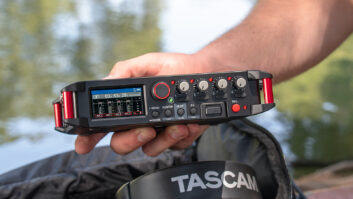
The PI 4100’s ergonomic design makes operation simple.
Field intensity meters, long a primary tool in AM field work, haven’t changed much. I have in my inventory Potomac FIM-21s, FIM-41s and even a 1950s-vintage RCA WX-2D (yes, it still works and “B” batteries are still available if you look hard).
Compare the old WX-2D to the FIM-21 or -41 and you won’t observe a lot of differences in either form or function. Sure, the more modern FIMs are solid-state, but the construction and operation essentially are the same.
That has changed with the introduction of the Potomac FI-4100 field intensity meter.
The 4100 doesn’t look anything like the legacy FIMs; it looks like something Dr. McCoy might have waved over a body before proclaiming, “He’s dead, Jim.”
Rather than a heavy metallic case and in-the-lid loop antenna, the case is molded plastic and the antenna is molded right in but perpendicular to the instrument body. It weighs only 5-1/2 pounds. Retail price is $14,975.
No scales
There are no “scales” to select — there is just one continuous scale, from below 25 uV/m to above 50 V/m (or 28 dBuV/m to 154 dBuV/m if you prefer those units; both are displayed). There is no “meter” — the field intensity is indicated digitally and with an “analog” linear scale on the LCD screen. Accuracy is specified as 3 percent.

The 4100 does not look anything like a traditional FIM. All of that is great — lighter weight, no need to calibrate, scale-less digital readout — but the new PI 4100 has something that no FIM before it has had: a built-in GPS receiver.
Together with the built-in flash memory for the storing of measurement data, this allows one-button onboard storage of field strength, distance, exact location, date and time. In my view, this is the defining feature of this piece of equipment.
When setting out to run a radial, perform walk-in or arc measurements, you won’t need to take a clipboard and paper with you. Simply find the point, orient the meter and push the save button. Data can be retrieved later via a USB interface with the supplied software and stored to a .CSV (Excel text) file. From there you can do anything you want with it by way of formatting, sorting, etc.
When I received the unit, it just took me a few minutes to create and store a station preset. Using the buttons on the front panel, I entered the call sign, frequency, station latitude/longitude and local magnetic variation.
Strength in the Field Potomac describes the PI 4100 as its third generation of survey instrumentation for the direct measurement of electromagnetic field strength in the 520 kHz to 5.1 MHz frequency spectrum.
Intended as a successor to the FIM-41, it incorporates a “laboratory quality” radio frequency voltmeter, a calibrated, shielded loop antenna, an internal GPS receiver, an internal calibration source and data acquisition hardware and software.
“This device is equipped with an embedded microcontroller engine that obtains measurement data from the various transducers within the instrument and formats that data for display and, at the option of the use, stores it to memory.”
Aspects highlighted by the company include a 116 dB dynamic range tuned RF voltmeter; digitally synthesized tuning in 1.0 kHz increments; spectrum display to facilitate compliance measurements (field strength, harmonic level and spectrum occupancy) in a single instrument; provisions for third-party calibration, using their laboratory standard, when it is impractical to return the instrument to the manufacturer; and data acquisition software and PC interface to enable collection, analysis and e-distribution of current field measurements. This last feature anticipates future acceptance of data e-filing by federal regulatory agencies.
Potomac says more than 80 units are in service now. Out in the field, I simply drove out the radial and then used the GPS bearing indicator to tell me when I was actually on the radial (it provides 0.1 degree resolution). As with any other FIM, the unit is oriented toward the station for the measurement. But what if the peak is broad and you can’t simply “DF” the station for the peak? No problem. The display provides the magnetic bearing to the station. There is a wet compass built right in on top of the loop antenna, so it’s a simple matter of orienting the unit in exactly the correct direction. Press save twice and you’re done.
When you press save, you can enter information about the pattern and/or measurement point. For example, you could note DA-D, DA-N or ND. You can also enter the radial azimuth and the initials of the operator. The unit automatically assigns a data point number (or you can change it), and each subsequent save automatically increments this number by one. So when running a radial, simply pressing save twice at each point increments the point number and stores the FI, distance, bearing, location, date and time, station and pattern ID, and other items.
Spectrum display
But there’s more. The unit also includes a spectrum display that can be handy in sniffing out the RF environment that you’re working in. During my test radial, I looked at the spectrum and could clearly see the digital sidebands of the station I was measuring as well as those of the station just up the band.
The unit will measure up to 5.2 MHz, which is more than adequate to measure any third-order products or harmonics of interest, even for expanded band stations.

All the info is in one place on the LCD screen. The 4100 comes with an internal rechargeable battery pack that Potomac says is good for five hours of operation. Battery voltage is continuously displayed on the screen, so there’s not a lot of excuse for running out of gas. It also comes with an AA battery holder that you can fill with alkaline or lithium cells to carry with you for those times when you do run out of juice in the internal battery. In addition to the supplied AC power pack for recharging, a 12 V lighter-plug automotive power cord is supplied.
As one who has spent a lot of the last 30 years behind a field intensity meter, I really appreciate all the thought that went into the PI 4100. It brings together a magnetic field meter, GPS, onboard memory and computer interface in a way that will make the job of the person out making measurements much easier.
Walk-in radials can actually be walk-out measurements with just one person (instead of the traditional two-person team). Drive-in measurements are much faster and safer without the need to check tuning, calibrate, note the field intensity and then try and remember it when you get back in the car.
Tweaks
There are a few things that Potomac could have done better.
Product Capsule Potomac PI 4100 Medium-Wave Field Strength Meter
Thumbs Up:
- • Ergonomic design
- • Measurement data storage
- • Integral GPS
- • Scale-less auto-calibration operation
- • Built-in wet compass
Thumbs Down:
- • Short battery life
- • No mapping
Price:
$14,975
For information contact Potomac Instruments at (301) 696-5550 or visitwww.pi-usa.com The five-hour battery life is too short to support a full-day’s measurements, and if you try to lengthen it by turning the unit off between measurements, you’ll find yourself waiting on a GPS lock each time you turn it back on. That can add five minutes to each measurement point, which really defeats the purpose. Keeping that AA alkaline pack loaded with fresh batteries and in your pocket is not optional for that type of work. If you are driving between measuring points, the supplied cord allows you to recharge while traveling with the unit left on.
I found that I still had to take another GPS unit with me to navigate. While the internal GPS gives you coordinates, distance, azimuth from and bearing to the station, there is no map function, so you still need something to help you get there. I wonder how much more it would add to the cost to include a map feature to make this a truly all-in-one self-contained unit.
Finally, while the 4100 is comfortable to use, it is not particularly comfortable to carry. Its odd shape makes it somewhat difficult to transport. With a legacy FIM, after making a measurement, most folks either set the unit in the other seat on its back or put it in the floorboard behind their legs. Either option is not too attractive with the 4100. It is light enough that it is prone to slide off the seat during turns and stops, and it’s just about impossible to safely put on the floor.
Those small issues aside, the Potomac PI 4100 is a home run.
Cris Alexander, a longtime RW contributor, is director of engineering for Crawford Broadcasting and a recipient of SBE’s Broadcast Engineer of the Year Award.







